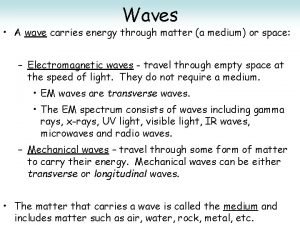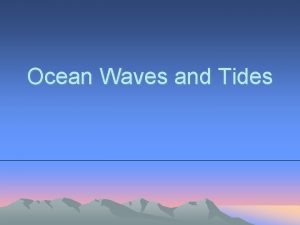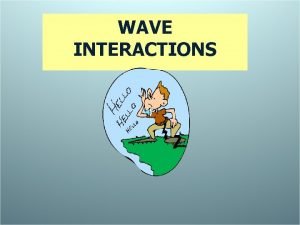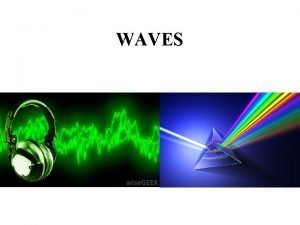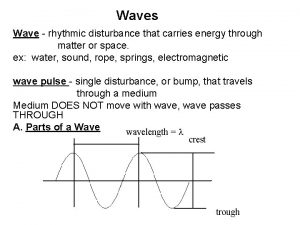Waves A wave carries energy through matter a





- Slides: 5

Waves • A wave carries energy through matter (a medium) or space: – Electromagnetic waves - travel through empty space at the speed of light. They do not require a medium. • EM waves are transverse waves. • The EM spectrum consists of waves including gamma rays, x-rays, UV light, visible light, IR waves, microwaves and radio waves. – Mechanical waves – travel through some form of matter to carry their energy. Mechanical waves can be either transverse or longitudinal waves. • The matter that carries a wave is called the medium and includes matter such as air, water, rock, metal, etc.

Transverse Waves Longitudinal Waves • Modeled by using a sine wave. • Modeled by using a spring. • Types include EM waves and ocean waves. • Sound waves are longitudinal waves. • Depending on the type of wave, transverse waves may or may not require a medium. • Longitudinal waves are mechanical waves – they require a medium. compression rarefaction

Waves do not require a medium Mechanical Waves transverse wave longitudinal wave Electromagnetic Waves light earthquake s-waves earthquake p-waves sound

Properties of Waves • Amplitude – Maximum height from resting position. The larger the amplitude, the more energy the wave carries. • Wavelength – The distance between successive identical parts of a wave. Represented by lambda, . • Crest – The high point. • Trough – The low point. • Period – The time needed for a wave to make one complete cycle (wavelength) of motion. Represented by T. Units of seconds. • Frequency – Number of cycles (wavelengths) per unit time. Represented by f. Units of hertz (Hz). Wavelength Crest Amplitude Trough Resting Position

Interference • Wave interference occurs when two or more waves are in the same place at the same time. A single wave is created. – When the crests of the waves overlap, constructive interference occurs and the resultant wave has an amplitude that is the sum of all the original waves’ amplitudes. – When the crests and troughs of the waves overlap, destructive interference occurs and the amplitude of the resultant wave is subtractive – it is smaller than the original waves or even cancelled out completely. Constructive Interference = Reinforcement + = Destructive Interference = Cancellation
